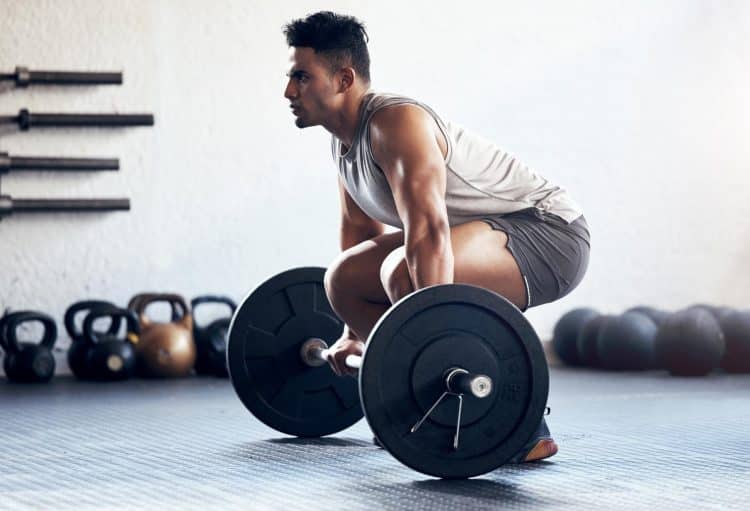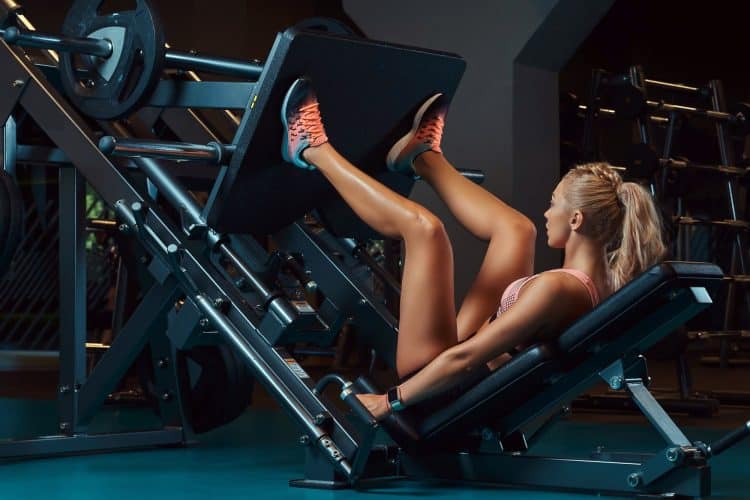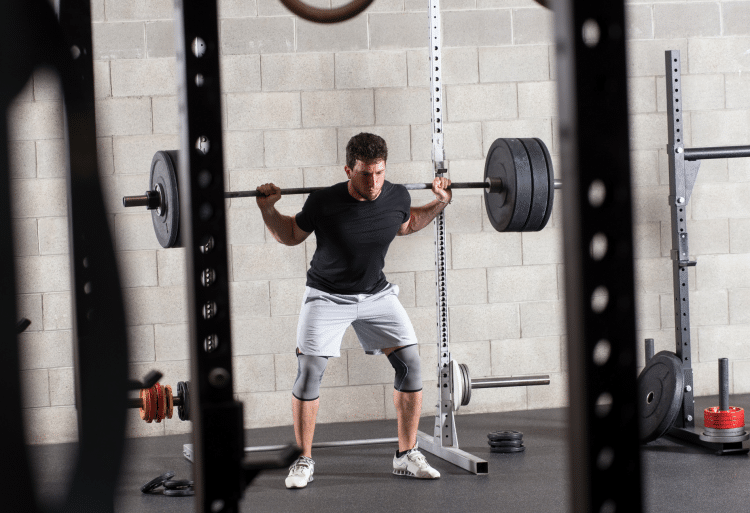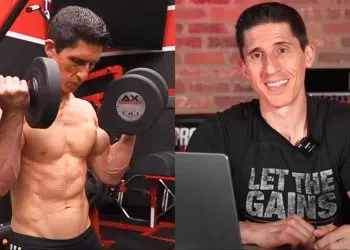Are partial reps cheating, or are they the key to building even more muscle and strength? The answer may surprise you!
Have you ever gone into a gym and seen someone doing partial reps? Maybe they were doing half-squats or not touching the bar to their chest during bench presses. Regardless of what they were doing, on seeing such a thing, most of us would quickly conclude that the lifter in question was cheating or otherwise undermining their progress.
And yet, in powerlifting and other athletic endeavors, partial range training is actually pretty common and used for a variety of performance-enhancing reasons. No one in a powerlifting gym would look twice if they saw you doing board presses or high box squats. In this scenario, partial reps are a tool used for very specific purposes.
With these conflicting points of view in mind, in this article, we delve into the science and practice of full vs. partial range of motion training so you can decide which approach is right for you.
What is Range of Motion and Why Does it Matter?

Before we get into the nitty-gritty of partial vs. full range of motion training, we need to define these terms so that we’re all on the same page.
Level Up Your Fitness: Join our 💪 strong community in Fitness Volt Newsletter. Get daily inspiration, expert-backed workouts, nutrition tips, the latest in strength sports, and the support you need to reach your goals. Subscribe for free!
Range of motion (ROM for short) refers to how far a joint moves. In anatomy, this is typically expressed in degrees, and there are accepted norms for all major joints (1). ROM is measured with a special device called a goniometer, a sort of protractor with moveable arms.
For example, a healthy knee should have a range of motion of around 120-150 degrees. In contrast, the shoulder joint, which is capable of many more movements, should be able to move through the following ranges:
- Flexion (lifting arm forward): up to 180 degrees
- Extension (moving arm backward): up to 60 degrees
- Abduction (lifting arm to the side): up to 180 degrees
- Adduction (moving arm across body): up to 50 degrees
- Internal rotation: up to 70 degrees
- External rotation: up to 90 degrees
However, exercise ROM is often less than the accepted norms for anatomical ROM. This is because the training implement used may impede range of motion, or using a full ROM could put excessive strain on the working joint, increasing the risk of injury.
As such, in training, full range of motion is typically defined as raising and lowering the load as far as is practical and safe. Examples of this include:
- Squatting until your thighs are at least parallel to the floor
- Bench pressing so the bar touches your chest
- Fully extending your knees during leg extensions and curls
- Pulling your chin up and over the bar during pull-ups
- Lowering the weight to your shoulders during overhead presses
While there are allowances for individual body types (limb length, flexibility, etc.), full range of motion is typically how most exercises are described in training manuals and performed by the majority of exercisers.
However, it’s important to note that range of motion can vary between lifters. For example, someone with a shallow chest and long arms will do bench presses with a larger ROM than someone with short arms and a barrel chest. Because of this, “full range of motion” is somewhat open to interpretation, and what’s a full ROM for one person may be a partial ROM for another.
With that said, a partial range of motion is anything less than the accepted ROM for a given exercise. Examples include:
- Quarter and half-depth squats
- Board presses, floor presses, and Spoto presses
- Rack pulls
- 21s biceps curls
- Overhead pin presses
As you can see, partial reps do not necessarily constitute cheating, and such a view is very myopic. In fact, most lifters will have done at least one of these exercises in their own training, even if they didn’t appreciate that it was a partial range exercise.
However, there is a time and a place for partial ROM training. That’s not to say it’s superior to full ROM, but both methods offer advantages and drawbacks. Knowing which to use when will help make your workouts as productive as possible.
The purpose of this article is to provide you with the information you need to choose between full and partial rep training.
Now you know the definitions for partial and full ranges of motion, next, we’ll explore the science behind these different types of training.
Full vs. Partial Range of Motion: What Research Tells Us
It’s easy to get bogged down in the science of exercise and training. There are often dozens, if not hundreds, of studies into what often are fringe topics that only the researchers really care about. Many of these studies are contradictory or biased, making it even harder to make an informed decision. Look hard enough, and you’re all but guaranteed to find a study that supports your point of view.
Thankfully, kindly researchers often gather all this information together to create meta-studies, which are overviews of the available literature that reveal helpful trends. In short, they add up and compare the results of multiple studies to find a consensus or what is probably the correct outcome.
With that in mind, this is what the current body of research tells us about partial vs. full-range training for strength, hypertrophy, and injury risk.
Strength Gains
Strength refers to how much force a muscle or muscles can generate and is typically expressed as your one-repetition maximum or 1RM for short. All forms of resistance training will make you stronger, but it’s best developed using low reps and heavy weights.
Full ROM: Studies have shown that full range of motion training can lead to more significant strength gains over time (2). This is likely due to the increased muscle activation and time under tension that full ROM provides.
Partial ROM: While partial ROM training can also yield strength gains, these are often specific to the range in which you train (3). For instance, quarter squats will improve your strength in that particular range but may not translate to a bigger full-depth squat.
Muscle Hypertrophy
Hypertrophy is another name for muscle growth and the aim of every bodybuilding program. Even non-bodybuilders want bigger muscles, as being more muscular can enhance your appearance and even your health. Hypertrophy is typically the result of medium to high rep-training with light to moderate weights.
Full ROM: Research suggests that full ROM training is generally more effective for muscle hypertrophy (4). The increased muscle activation and stretch during full ROM exercises are responsible for this.
Partial ROM: Partial ROM can also be effective for hypertrophy, especially when targeting specific muscle groups or overcoming plateaus (5). However, it’s generally less effective than full ROM for overall muscle development, as training a muscle in a stretched position usually triggers greater hypertrophy.
Injury Prevention
No one likes being injured, yet bodybuilding injuries are often part and parcel of pushing your muscles and joints to their limit in the gym. Partial and full-range reps affect your joints differently, so it pays to know how.
Full ROM: One of the benefits of full ROM is that it can help improve joint health and flexibility, reducing the risk of injury (6). Full ROM exercises like lunges and squats are also helpful for improving mobility and flexibility, essentially injury-proofing your body.
Partial ROM: In contrast, partial ROM exercises can put excessive strain on the joints and may increase the risk of injury if not performed correctly (7). This is probably because most partial ROM exercises allow you to lift heavier loads, putting more stress on your joints.
Practical Takeaways
Both partial and full ROM training can help you reach your training goals, and one is not inherently better than the other (8). Full ROM is generally better for overall development and functional fitness. At the same time, partial ROM can be useful for targeting specific weaknesses or breaking through plateaus.
While it’s easy to dismiss partial reps as cheating, used correctly, they can be very beneficial but should mainly be used in conjunction with full ROM exercises. It would probably be a mistake to overemphasize partial reps or use them as your primary training modality.
With the science of partial vs. full reps covered, it’s now time to move into the pros and cons of these methods so you can decide which to use and when.
Full vs. Partial Range of Motion: Pros and Cons
Where bodybuilders tend to emphasize full range of motion training in their workouts, powerlifters strategically use partial reps to improve their strength and performance. In this context, partial ROM movements are accessory exercises. As such, and this POV is supported by studies, both training methods have value.
But which should you use?
In this section, we reveal the pros and cons of full vs. partial reps so you can pick the best one for your needs and goals.
Full ROM Benefits
Greater strength gains – using a full range of motion makes the most of the stretch-shortening reflex and the ability of your tendons to store and release energy. These factors may lead to more significant strength increases.
Enhanced hypertrophy – some of the best muscle-building exercises utilize a full range of motion, including overhead triceps extensions, dumbbell bench presses, Romanian deadlifts, and deep squats. Loading a muscle in a stretched position is strongly linked to increased hypertrophy (9).
Increased muscle activation and time under tension – full ROM reps invariably take longer than shortened reps. This keeps your muscles under tension for longer and may increase muscle motor unit activation as a result. Both of these factors contribute to hypertrophy.
Improved joint health and flexibility – like your muscles, your joints respond to the type of training you do. So, if you do exercises with a large ROM, your mobility will naturally improve. In general, mobile joints are healthy joints.
Functional fitness benefits – many of the activities of daily living involve a large range of motion. Doing full ROM exercises is arguably the best way to prepare your body for these challenges.
Reduced risk of injury – full ROM exercises are generally more natural and put less stress on your joints than partial ROM movements. As such, full range of motion exercises should be your go-to choice for most of your workouts.
Full ROM Drawbacks
May not target specific weaknesses – most exercises have a sticking point, which is where you are most likely to fail your lift. This may be where the weight is furthest from your body, or your joints and muscles are in their most mechanically disadvantageous position. Either way, full ROM exercises do not address this weakness, and that sticking point will always limit your performance in that exercise.
Greater technical skill required – exercises with a full range of motion often require a lot of mobility, flexibility, stability, and balance. For example, deep squats are far more technically demanding than partials. Partial reps usually need less mobility, flexibility, etc.
Lower training loads – full ROM exercises involve more work (work = load x distance). This means you won’t be able to use as much weight as you could for partial reps. This is why many lifters gravitate toward partial reps; they want to be seen lifting the heaviest possible loads.
Partial ROM Benefits
Targeted strength gains – partial ranges of motion can be helpful for targeting specific parts of a movement, e.g., bench press lockout or liftoff during a deadlift. Strength gains from partial ROM training are specific to the range of motion/joint angle you use.
Overcoming plateaus and sticking points – leading on from the point above, you can use partial ROMS to overcome plateaus and sticking points. For example, if your bench press always stalls with the bar halfway between your chest and lockout, working in this ROM could help fix the problem.
Ability to lift heavier weights – leading on from the points above (again!), working in a partial ROM will allow you to lift heavier weights and, therefore, develop more strength. Partial reps are an effective way to expose your muscles to heavier than normal loads.
Less technical skill required – partial movements often require less technical skill than the same exercise done using a full range, e.g., half squats vs. full-depth squats or rack pulls vs. deadlifts from the floor. However, this is not always the case.
Partial ROM Drawbacks
Strength gains are range of movement-specific – because of the fitness law of specificity, your body adapts to the workouts and exercises you do. Therefore, if you mostly do half squats, you’ll get better at half squats. However, if you want to improve your strength for full-depth squats, full ROM training is better.
Increased risk of joint strain – the greater loads that partial ROM training allows means more joint stress. This could result in acute and chronic injuries. Muscle tears and tendon injuries may also be more prevalent.
Fewer functional fitness benefits – most athletic and everyday activities challenge your muscles through a large range of motion, e.g., bending down to pick an object up from the floor or putting something heavy on an overhead shelf. Partial ROM exercises are less effective for preparing your muscles for these types of activity.
May lead to overconfidence in lifting abilities – just because you can half-rep bench press 300 pounds doesn’t mean you can handle the same weight for full bench presses. Overconfidence in your lifting abilities can cause serious injuries, especially in exercises where there is a danger of getting pinned by a heavy weight.
Now that you understand the pros and cons of full vs. partial rep training, in the next section, we reveal the most effective ways to use partial reps in your strength training and bodybuilding workouts.
How to Use Partial Range of Motion Training
You should now have a pretty good idea of when to use full vs. partial reps in your training. As a general rule, full ROM should be the cornerstone of your workouts, while you can use partial ROM training to elicit specific effects and adaptations. Think of partial ROM training as a supplement to and not a replacement for full ROM reps.
With that in mind, here are some of the best ways to use partial reps.
Level Up Your Fitness: Join our 💪 strong community in Fitness Volt Newsletter. Get daily inspiration, expert-backed workouts, nutrition tips, the latest in strength sports, and the support you need to reach your goals. Subscribe for free!
Overcoming Sticking Points
Powerlifters have been using partial reps for years to increase their strength and overcome sticking points. In simple terms, they reduce their range of motion so that they work specifically where they’re weakest. This could be the start of a deadlift or the mid-point of the bench press.
So, if you have a notable sticking point, which suggests either a muscle or biomechanical weakness, you can work on it and make it less of a liability.
Ways to do this include:
- High box squats – to improve squat lockout strength.
- Rack pulls – to improve deadlift lockout strength.
- Board and Spoto presses – to improve bench press lockout strength.
- Partial deadlift to knees – to increase your strength off the floor.
Use your imagination to target your sticking points with partial reps.
As A Form of Progression
Legendary strongman Paul Anderson routinely used partial reps to build his incredible strength. When working toward a new record in the squat, he would load up the bar with the requisite weight and do partial reps with it. Then, as he got stronger and as a form of progression, he’d gradually increase the range of motion until he could use that weight for full ROM reps.
Anderson did this by digging a hole beneath his squat rack and gradually filling it in to raise him up. You can achieve a similar (and more gym-friendly) effect by adjusting the safety bars in a power rack.
To Get a Better Pump
Bodybuilders value a good muscle pump. This is when a muscle is flooded with blood, making it temporarily bigger. They believe a pump promotes hypertrophy by infusing the muscle with nutrients and stretching the surrounding fascia to make more room for growth. While the pump is mostly bro science, there is no denying it feels good!
Partial ROM training, especially for high reps, causes partial occlusion of the muscle being trained. This means blood flow into and out of the muscle is restricted. Then, when you end your set, backed-up blood comes rushing into the area, resulting in a pump.
If you want to get a great pump and deep burn in your muscles, partial rep training will do it for you.
Train beyond failure
Just because you cannot do any more full-range reps doesn’t mean your muscles are fully exhausted. In fact, there are probably lots of motor units that are untested. Doing partial reps at the end of a full ROM training set is an effective way to fatigue even more muscle fibers.
For example, do full-range leg extensions to failure, then crank out as many partial reps as you can tolerate. While this is a painful training method, it could be the thing that takes your muscles to a new level of growth. Bodybuilders call these burn reps, which is indicative of how this training method will make your muscles feel.
Related: Why, When, and How to Train to Failure
For Variety
Variety is a critical part of bodybuilding training. Your progress will soon plateau if you do the same exercises for the same sets and reps over and over again.
Bodybuilders use a variety of methods to vary their workouts and avoid training ruts, including things like drop sets, supersets, pyramids, and negative reps. And now you can add partial ROM training to your workout toolbox.
Use partial reps to add more variety to your workouts. For example:
| # | Exercise | ROM | Sets | Reps | Rest Period |
| 1 | Squats | Full ROM | 4 | 8-12 | 90-120 secs |
| 2 | Half Squats | Partial ROM | 3 | 10-15 | 60-90 secs |
| 3 | Romanian Deadlifts | Full ROM | 4 | 8-12 | 90-120 secs |
| 4 | Rack Pulls | Partial ROM | 3 | 10-15 | 60-90 secs |
| 5 | Bulgarian Split Squats | Full ROM | 3 | 10-12 per leg | 60-90 secs |
| 6 | Leg Press (Top Half Range) | Partial ROM | 3 | 12-15 | 60-90 secs |
| 7 | Seated Calf Raises | Full ROM | 3 | 15-20 | 60 secs |
| 8 | Standing Calf Raises | Partial ROM | 3 | 15-20 | 60 secs |
Notes:
- Squats: Focus on going as deep as your mobility allows, aiming for thighs parallel to the ground or lower.
- Half Squats: Lower yourself only halfway down, focusing on the top half of the squat motion.
- Romanian Deadlifts: Keep a slight bend in the knees and hinge at the hips to work the hamstrings and glutes.
- Rack Pulls: Set the barbell on a rack at knee height and perform the top half of the deadlift motion.
- Bulgarian Split Squats: Place one foot on a bench behind you and perform a lunge, aiming for a deep stretch in the front leg.
- Leg Press (Top Half Range): Adjust the safety stops to limit the range of motion to the top half of the leg press.
- Seated Calf Raise: Lower your heels as far down as possible and then rise up on tiptoes.
- Standing Calf Raise: Start on your tip toes, lower your heels partway down, and then push back up onto your toes. Continue until the burn becomes intolerable.
21s
21s, also known as the matrix method, combines partial reps with full reps. Most bodybuilders use this method with biceps curls, but it can actually be done with almost any exercise.
This method is so-called because you split your reps into two halves and do seven of each plus seven full reps to total 21. For example, with a barbell for biceps curls:
- Starting with your arms straight, do seven half-reps, stopping when your elbows are bent to 90 degrees.
- Next, do seven half reps from 90 degrees to full elbow flexion.
- Finally, do seven full ROM reps, from extension to full flexion.
21s produce a deep burn and powerful pump and are a great way to add variety to your workouts. However, this is a hypertrophy training method and less effective for building strength.
Check out this video to see 21s in action!
Now you know how and why to use partial reps, let’s wrap things up with an FAQ to ensure we leave no knowledge stone unturned!
Full vs. Partial Range of Motion Training – FAQs
Do you have a question about full vs. partial range of motion training? That’s okay because we’ve got the answers!
1. What is the difference between full ROM and partial ROM training?
As a general rule, full ROM training involves doing an exercise with the largest safe range of motion. This may be limited by the implement you are using. For example, the full ROM for dumbbell bench presses is typically greater than for barbell bench presses. The full ROM is typically how an exercise should be performed if you follow the recognized guidelines, i.e., as taught by a gym instructor.
In contrast, a partial ROM is anything less than the full ROM. This can be anything from half-reps to quarter-reps to moving the weight just a few inches.
2. Are partial reps considered “cheating” in bodybuilding?
Somewhat confusingly, partial reps are sometimes considered cheating even though they often feature in bodybuilding workouts, e.g., floor presses, rack pulls, and 21s.
The real issue is when someone claims a weight or rep record but didn’t do full reps. For example, doing half-depth squats is much easier than full squats. In this instance, partial reps could be considered cheating.
But if you aren’t a competitive lifter and aren’t trying to claim any kind of record, partial reps may not constitute cheating.
3. How do I identify my sticking points for partial ROM training?
Sticking points are usually easy to spot. It’s where your rep grinds to a halt, and you typically fail. In most cases, this is when the weight is furthest from your body, e.g., at 90 degrees of elbow flexion during biceps curls or a mechanically advantageous position, such as halfway up during a squat or bench press.
Using a spotter for safety, take your set to failure and note when your movement grinds to a halt. That’s probably your sticking point. Use low reps with this experiment to ensure you aren’t just failing because of metabolic fatigue.
4. Can I combine full ROM and partial ROM exercises in the same workout?
You certainly can! This is arguably the most intelligent way to approach full and partial ROM training. Consider starting your workout with heavy partials to fire up your central nervous system and make your subsequent exercises feel easier. Alternatively, do partials near the end of your workout as a finisher. Both options work great.
5. What are some common exercises that can be modified for partial ROM training?
You can use partial ROM training with almost any exercise. Good options include:
- Abdominal crunches
- Bench presses
- Biceps curls
- Calf raises
- Deadlifts
- Lat pulldowns
- Lateral raises
- Leg curls
- Oblique crunches
- Leg extensions
- Leg presses
- Overhead presses
- Pec deck flyes
- Pull-ups/chin-ups
- Push-ups
- Squats
- Triceps pushdowns
6. Is partial ROM training safe for beginners?
Partial reps are generally best left to more experienced exercisers. As a beginner, you should spend your time learning and mastering the basics before trying more advanced training methods. Plus, if you start doing partial reps too soon, you may resort to doing them all the time, which is a bad habit that’ll be tough to break.
Basic lifting techniques should be stimulus enough to build muscle mass and strength, so save partial rep training for when those basics are no longer effective.
7. How often should I incorporate partial ROM exercises into my routine?
Partial reps expose your muscles to a heavier than typical training load. As such, this training method will take a lot out of your body. Because of this, you should probably limit partial ROM training to once per week per major muscle group. More often than this could lead to overtraining and overuse injuries.
8. Are there any specific muscle groups that benefit more from partial ROM training?
There are no hard and fast rules for which muscles benefit most from partial rep training. In fact, you can probably use it for all major and minor muscle groups, from your calves to your traps and everything in between. Experiment to discover what works best for you.
9. Can partial ROM training help with injury rehabilitation?
Injury rehab often starts with isometric/static exercises that progress to partial and then full ROM exercises. For example, over several weeks, you might do:
- Half-depth wall squat
- Full walk squat
- Quarter-depth dynamic squat
- Half-depth dynamic squat
- Full-depth dynamic squat
- Weighted squat
Gradually increasing your ROM is an excellent way to develop mobility and strength without overtaxing your muscles, joints, or connective tissue. However, it’s generally best to use an approach like this in conjunction with advice from a sports injury or rehabilitation expert.
10. Are full ROM reps better than partial reps?
Asking whether full ROM reps are “better” than partial ROM reps is like asking if a hammer is better than a screwdriver; it really depends on what you’re trying to do.
If you’re aiming for overall muscle development, joint health, and functional fitness, then full ROM should be your first choice. These exercises engage more muscle fibers and are generally more applicable to real-world activities and improving functional performance.
In contrast, partial ROM exercises can be helpful for targeting specific weaknesses or overcoming plateaus. For example, powerlifters often use partial reps to work on sticking points in their lifts.
So, in the grand scheme of things, a balanced training program will lean heavily on full ROM exercises, with partial ROM exercises added as needed for specific goals. Think of partial ROM as a specialized tool in your training toolbox, not the whole kit and caboodle. By tailoring your approach, you can make the most of both worlds.
Do you have any more questions? Feel free to ask them in the comments section below, and we’ll get back to you ASAP!
Related Content:
- Half Biceps Curl: Better Than Full Range for Muscle Growth?
- A Rep And A Half Routine – Bodybuilding Routine That Works
- All Rep Ranges: Perfect Muscle Building Routine
- Best Rep Range For Building Muscle, Strength
Closing Thoughts
Partial reps can be decisive, with some people thinking that they’re cheating, while others believe that range of motion doesn’t matter.
Unfortunately, both of these points of view are wrong.
Partial reps are only cheating if you cut your ROM short to make an exercise easier. That’s why powerlifters have rules determining things like squat depth. In fact, these same athletes often use partial reps to strengthen sticking points and improve their overall lifting performance.
Similarly, bodybuilders can utilize partial reps to overload their muscles and trigger increased hypertrophy. Try some partial biceps curls after your usual set to experience the power of this technique for yourself.
That said, performing exercises through a full range of motion should be the cornerstone of your training. Half-repping has its place, but full reps are usually more productive, even if they mean you can’t go as heavy or do as many reps.
So, partial reps don’t necessarily mean you are cheating, but there is a right and a wrong time to use a reduced ROM. Use the information in this article to make choosing between full and partial reps easier.
Not used partial ROM training before? Well, maybe it’s time to try it for yourself!
References:
1 – Soucie JM, Wang C, Forsyth A, Funk S, Denny M, Roach KE, Boone D; Hemophilia Treatment Center Network. Range of motion measurements: reference values and a database for comparison studies. Haemophilia. 2011 May;17(3):500-7. doi: 10.1111/j.1365-2516.2010.02399.x. Epub 2010 Nov 11. PMID: 21070485.
2 – Pinto RS, Gomes N, Radaelli R, Botton CE, Brown LE, Bottaro M. Effect of range of motion on muscle strength and thickness. J Strength Cond Res. 2012 Aug;26(8):2140-5. doi: 10.1519/JSC.0b013e31823a3b15. PMID: 22027847.
3 – Bloomquist K, Langberg H, Karlsen S, Madsgaard S, Boesen M, Raastad T. Effect of range of motion in heavy load squatting on muscle and tendon adaptations. Eur J Appl Physiol. 2013 Aug;113(8):2133-42. doi: 10.1007/s00421-013-2642-7. Epub 2013 Apr 20. PMID: 23604798.
4 – McMahon GE, Morse CI, Burden A, Winwood K, Onambélé GL. Impact of range of motion during ecologically valid resistance training protocols on muscle size, subcutaneous fat, and strength. J Strength Cond Res. 2014 Jan;28(1):245-55. doi: 10.1519/JSC.0b013e318297143a. PMID: 23629583.
5 – Massey CD, Vincent J, Maneval M, Moore M, Johnson JT. An analysis of full range of motion vs. partial range of motion training in the development of strength in untrained men. J Strength Cond Res. 2004 Aug;18(3):518-21. doi: 10.1519/13263.1. PMID: 15320644.
6 – Rhea MR, Alvar BA, Burkett LN, Ball SD. A meta-analysis to determine the dose response for strength development. Med Sci Sports Exerc. 2003 Mar;35(3):456-64. doi: 10.1249/01.MSS.0000053727.63505.D4. PMID: 12618576.
7 – Schoenfeld BJ, Grgic J. Effects of range of motion on muscle development during resistance training interventions: A systematic review. SAGE Open Med. 2020 Jan 21;8:2050312120901559. doi: 10.1177/2050312120901559. PMID: 32030125; PMCID: PMC6977096.
8 – Ogasawara R, Thiebaud RS, Loenneke JP, Loftin M, Abe T. Time course for arm and chest muscle thickness changes following bench press training. Interv Med Appl Sci. 2012 Dec;4(4):217-20. doi: 10.1556/IMAS.4.2012.4.7. Epub 2012 Dec 27. PMID: 24265879; PMCID: PMC3831787.
9 – Warneke K, Lohmann LH, Lima CD, Hollander K, Konrad A, Zech A, Nakamura M, Wirth K, Keiner M, Behm DG. Physiology of Stretch-Mediated Hypertrophy and Strength Increases: A Narrative Review. Sports Med. 2023 Aug 9. doi: 10.1007/s40279-023-01898-x. Epub ahead of print. PMID: 37556026.











